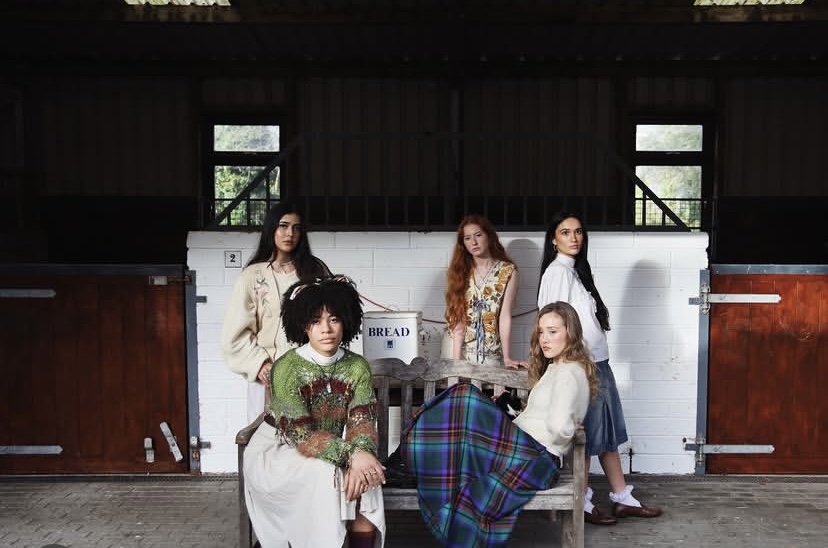by Ava Staunton

This article will explore how our landscape influenced not only fashion but also contributed to our rich heritage of strong vibrant colours and natural fabrics sourced from our beautiful Land.
The shores of the Aran Islands unfold to surround memories of the women who once passed along the coastline in their warm woven shawls. The weight of the wool held them tethered to solid rock covered in clover. Local fishermen sail into the harbour carrying fine silk from foreign lands. Knitted croís belts hugged their torsos, a kaleidoscope of colours to identify them while away at sea. Rather than woven with a loom, the belts are stretched between two stools, between oceans sailed across. Napped skirts were lifted, and tweed trousers rolled above the knee, as the islander’s ankles submerged in the glistening banks of emerald to help unravel the imported pearly silk. The women would protect materials under their velveteen cloaks that billowed in the wind from the thunderstorms of Aranmore. Warriors of Irish heritage preserved in the seams of their ethereal garments. The sagas of queen Maeve who swooped her silken cape from behind her shoulders as the winds of Connacht kept it adrift. Bástchótaí waistcoats were fastened with security and rigidness, elongated into a stoic bodice to keep them upright against turbulent winds. Like the tall rock sloping up from the amorphous sea, as a figure in the surf.
Within the thatched cottages, wispy yarn hung off the spindle wheel and swooped like the delicate white centre of the tricolour flag. An eternal promise between gold and green was interwoven into the ridges and valleys of intricate knitted patterns. Patterns today reflect the speckled sheep and foamy sea of the country landscape. Carrageen moss similarly stitches details of the flora across a millennium. Forty shades of knitted green that would fall down the valley of fishermen’s shoulders, with diamond motifs that framed their netted rods in hopes of a triumphant catch. The women stood bold against the terrains in cótaí dearga as dotted rubies encased in limestone formations. A splash of vibrant berries against the earthiness of the turf-smoked walls. To not disturb the fairies, they were warded off through the vermilion hew of their garments. Stepping over their fairy forts in the pampootie shoes of delicate cowskin. The women who like the fairies, flew around their own mushroom caps as fierce guardians of their abodes. Red ribbons tied in their hair danced freely through the air. The scarlet flames rose high, as the needle sewed its accompanying stitch, and the fairies were left in their own realm.
The red thread extends through lifetimes into the present day, a fibre of Celtic heritage tying us together for protection and preservation of what is golden and green. Flashing upon the embezzled sequences of Riverdance costumes in modern times. Where pointed feet frolic in pampootie-like pumps similar to Russian Bereza dancers that appear to be floating above moving water. Their poppy-coloured floor-length dresses dance across the land as those of the petticoat skirts of Inishmore. The triskele’s Celtic symbol of constant motion continues to circulate the island, a gusting trinity that cannot be untied. The history of Ireland interwoven into the seams of our clothing today like Saint Brigid’s Cloak, Godmother of Ireland. Mná na hÉireann harvest a new patch of green to the quilt that spreads and unifies across the land. An emblem whirling through its embroidery from Mother to Daughter. Rolling over the red poppies across the hill of Tara, and beyond, as an evergreen moss.